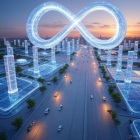What Happens When Electricity Becomes Smart with AI
For over a century, electricity has been a mostly one-way system: power stations generate energy, and homes, businesses, and factories consume it. But that model is rapidly evolving. With the rise of artificial intelligence (AI), the grid is no longer just wires and transformers — it’s becoming a thinking, learning infrastructure.
The moment electricity “meets” AI, the entire system begins to adapt, predict, and optimize in real time. This transformation is quietly rewriting the way energy is managed, distributed, and even controlled across cities and countries.
🧠 How AI Makes the Grid Smarter
At the heart of this evolution is data — massive amounts of it. AI algorithms analyze weather patterns, usage trends, appliance behavior, and even human routines to make smarter energy decisions. Here’s what that enables:
- Real-Time Demand Forecasting
- AI can predict when electricity usage will spike — like on hot afternoons or during national events — and adjust supply before strain hits the system.
- Dynamic Load Balancing
- Instead of blackouts during peak hours, AI shifts power flows to avoid overload. It balances the grid like traffic control for electricity.
- Integration of Renewables
- Solar and wind energy are variable. AI helps predict when they will generate power and smoothly blend them into the grid, reducing reliance on fossil fuels.
- Smart Storage and Discharge
- AI tells battery systems when to store excess energy and when to release it for maximum economic and ecological benefit.
🔐 The Control Dilemma: Who’s in Charge?
While AI improves efficiency and sustainability, it also raises tough questions about control. As the grid becomes “smart,” it becomes programmable — and whoever controls the AI can potentially:
- Prioritize power access based on algorithms or economic tiers
- Automate disconnections for non-payment or policy violations
- Analyze your energy behavior in ways that challenge privacy
In centralized systems, this could mean more efficient management. But it could also lead to digital authoritarianism, where access to basic utilities is influenced by opaque data policies.
🏘️ A Future of Decentralized Intelligence?
Not all is doom and gloom. Emerging models like peer-to-peer energy trading, microgrids, and open-source AI for energy show a different path: where communities manage their own energy intelligently, fairly, and locally.
Imagine a neighborhood that powers itself with solar panels, stores excess energy, and sells it via blockchain-based AI to nearby homes — all without needing a big utility in the middle.
This could democratize energy, reduce costs, and make grids more resilient to cyberattacks and political pressure.
🚨 Risks, But Also Opportunities
Smart grids powered by AI will bring new challenges: algorithmic bias, data security, over-reliance on tech. But they also present a unique opportunity to rethink the energy equation — not just as a utility, but as a core infrastructure of freedom, equity, and survival in a warming world.
Whether AI in energy becomes a tool of control or empowerment depends on how we design, regulate, and share it.
🌍 Real-World Case Studies: AI Grids in Action
🇩🇪 Germany: AI as the Backbone of Renewable Integration
Germany’s Energiewende — its aggressive transition to renewable energy — has pushed the national grid to its limits. Solar and wind now make up more than 50% of electricity production, but their unpredictability is a constant challenge.
To solve this, Germany’s grid operators partnered with AI companies like Siemens and gridOS to build systems that predict renewable generation up to 48 hours in advance. AI models process satellite data, wind speeds, and consumption patterns to smooth out surges and drops.
In one pilot region, this reduced curtailment (wasted energy due to oversupply) by 30%, helping Germany avoid blackouts while slashing carbon emissions.
🇨🇳 China: AI-Powered State Grids and Surveillance Concerns
China operates the world’s largest electricity grid, with over 1.1 billion consumers. The State Grid Corporation of China has embraced AI not only for efficiency but also for political stability.
AI monitors demand, detects anomalies, and predicts failures before they happen. But it also links with social governance systems. In smart cities like Hangzhou, power usage data is integrated with surveillance and credit systems — enabling both predictive energy management and control over citizen behavior.
While technically impressive, this model raises ethical concerns about energy as a tool of centralized authority.
🇺🇸 United States: Decentralized AI in Texas and California
After the devastating Texas blackout in 2021, private firms like Tesla Energy and Google DeepMind stepped in with decentralized AI energy systems.
- Tesla’s Autobidder AI helps homes and businesses with Powerwall batteries to trade energy on local markets in real time.
- In California, Google’s DeepMind is helping manage peak demand and prevent wildfires by adjusting energy flows based on weather, terrain, and grid stress.
These efforts prioritize resilience and market flexibility — and hint at a future where individuals participate actively in smart energy ecosystems.
🔎 Conclusion (Informed, Not Just Inspired)
Smart grids infused with AI are not science fiction — they’re already shaping national infrastructure. But the direction they take is still open: toward democratized, decentralized energy, or toward efficient yet opaque systems of control.
Every country is writing its own version of this story, with AI as the invisible author behind the scenes. The question is: will the next page empower citizens — or monitor them?






